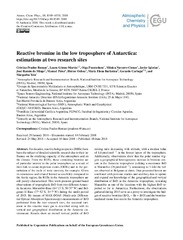Mostrar el registro sencillo del ítem
Reactive bromine in the low troposphere of Antarctica: estimations at two research sites
| dc.contributor.author | Prados-Roman, Cristina | |
| dc.contributor.author | Gómez-Martín, Laura | |
| dc.contributor.author | Puentedura, Olga | |
| dc.contributor.author | Navarro-Comas, Mónica | |
| dc.contributor.author | Iglesias, Javier | |
| dc.contributor.author | Mingo, José Ramón de | |
| dc.contributor.author | Pérez, Manuel | |
| dc.contributor.author | Ochoa, Héctor | |
| dc.contributor.author | Barlasina, María Elena | |
| dc.contributor.author | Carbajal Benítez, Gerardo | |
| dc.contributor.author | Yela, Margarita | |
| dc.date.accessioned | 2019-04-24T17:36:14Z | |
| dc.date.available | 2019-04-24T17:36:14Z | |
| dc.date.issued | 2018 | |
| dc.identifier.uri | http://hdl.handle.net/20.500.12160/997 | |
| dc.identifier.uri | DOI: https://doi.org/10.5194/acp-18-8549-2018 | |
| dc.identifier.uri | https://creativecommons.org/licenses/by/4.0/legalcode | |
| dc.description | Artículo publicado en la Revista Atmospheric Chemistry Physics, No.18, p. 8549–8570, 2018. | es |
| dc.description.abstract | For decades, reactive halogen species (RHSs) have been the subject of detailed scientific research due to their influence on the oxidizing capacity of the atmosphere and on the climate. From the RHSs, those containing bromine are of particular interest in the polar troposphere as a result of their link to ozone-depletion events (ODEs) and to the perturbation of the cycle of toxic mercury, for example. Given its remoteness and related limited accessibility compared to the Arctic region, the RHSs in the Antarctic troposphere are still poorly characterized. This work presents ground-based observations of tropospheric BrO from two different Antarctic locations: Marambio Base (64 130 S, 56 370 W) and Belgrano II Base (77 520 S, 34 70 W) during the sunlit period of 2015. By means of MAX-DOAS (Multi-axis Differential Optical Absorption Spectroscopy) measurements of BrO performed from the two research sites, the seasonal variation in this reactive trace gas is described along with its vertical and geographical distribution in the Antarctic environment. Results show an overall vertical profile of BrO mixing ratio decreasing with altitude, with a median value of 1.6 pmol mol1 in the lowest layers of the troposphere. Additionally, observations show that the polar sunrise triggers a geographical heterogeneous increase in bromine content in the Antarctic troposphere yielding a maximum BrO at Marambio (26 pmol mol1), amounting to 3-fold the values observed at Belgrano at dawn. Data presented herein are combined with previous studies and ancillary data to update and expand our knowledge of the geographical and vertical distribution of BrO in the Antarctic troposphere, revealing Marambio as one of the locations with the highest BrO reported so far in Antarctica. Furthermore, the observations gathered during 2015 serve as a proxy to investigate the budget of reactive bromine (BrOx DBrCBrO) and the brominemediated ozone loss rate in the Antarctic troposphere. | es |
| dc.language.iso | eng | es |
| dc.publisher | Atmospheric Chemistry and Physics | es |
| dc.subject | ANTARCTIC TROPOSPHERE | es |
| dc.subject | ESTIMATIONS | es |
| dc.title | Reactive bromine in the low troposphere of Antarctica: estimations at two research sites | es |
| dc.type | Artículo | es |
